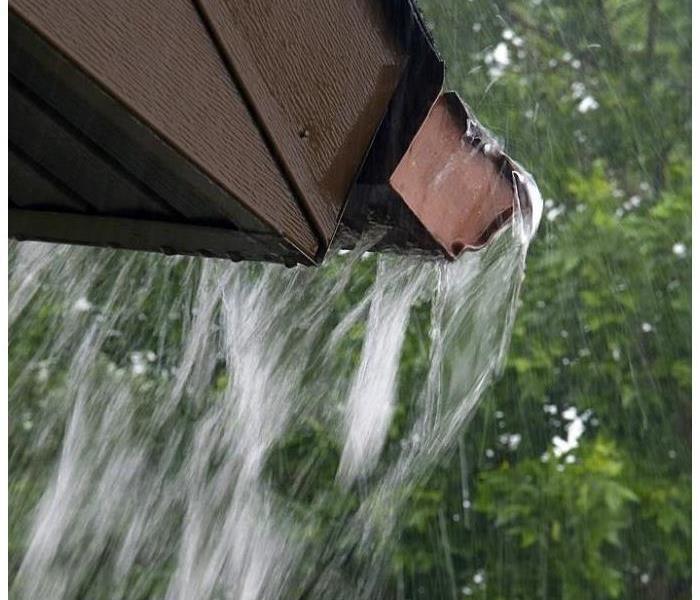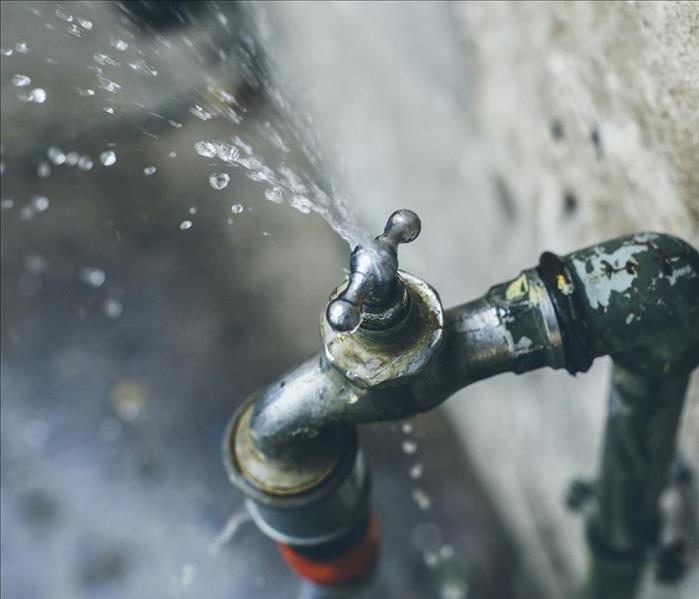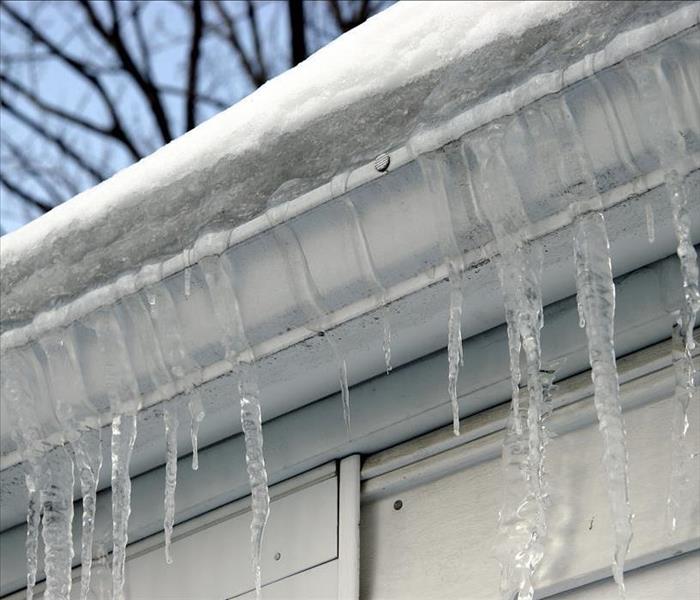Archived Water Damage Blog Posts
Clogged Gutters
5/18/2021 (Permalink)
 Clogged gutters cause overflow when it rains
Clogged gutters cause overflow when it rains
Water from outside your home can find its way inside if your gutters are not cleaned.
What clogs gutters?
Last year's fall leaves, springtime pollen, seed pods, tree debris are among a few.
How water find its way inside my home?
When clogged gutters overflow water can run down along your home's exterior walls and pool up at your foundation. If your foundation has defect such as a crack, no matter how small, water can potentially find its way in.
How can I help prevent this?
Routinely clean have your gutters cleaned. This includes the gutters secured to your roofline and all downspouts. If you have a French drain system, the underground drain should be flushed as well. This can be done with a water pressure or air pressure, whichever is recommended for your type of drainage system.
Water is On keep it Out
5/18/2021 (Permalink)
 Water leak in need of repair
Water leak in need of repair
Spring is here! The weather is warming up and you probably opened the valve to allow water to flow to the outdoor spigots. Hoses are hooked up and sprinklers are watering the law and gardens.
It’s time to start a routine to inspect your hoses, spigots and sprinkler systems for potential leaks, cracks and defects. This is not just important to help avoid that surprise high water bill, but to also help avoid that surprise basement flood.
Just like an overflowing gutter can cause water to pool around your foundation, so can water pooling from your home use water systems. Finding the right solution to prevent water damage to your home is important. Issues you may encounter can be rectified by something as simple as replacing your garden hose or a more involved problem that could require a professional plumber.
Take the first step and inspect your homes exterior water sources and equipment.
Inspection for Prevention and Action for Extraction
3/6/2020 (Permalink)
Water knows no bounds. It can seep in through the tiniest of openings, cracks or penetrate through permeable surfaces. Over time water is capable of carving its own path throughout your home or business.
Although it may be impossible to prevent every water loss in all situations, it is possible to lower the potential of occurrence and extent of the damage. This can be done by getting to know your home or business inside and out.
Routinely service and/or check things like water pipes, fire suppression systems, chimney structure and flashing, weather seals around windows and doors, and also your water consumption. A water leak can accumulate over time and can cause your water bill to go up when your normal usage has not. Going undetected over an extended period of time the resulting water damage can be destructive.
If you see something, say something. It may seem like just a small pooling of water in a bathroom or common area, but the extent of the condition could be much worse. Where did the water come from? How long has the water been there? Has the water traveled to another location through the floor or wall? Have any contents or structures (i.e. walls, cabinets, sub-floor, etc.) been effected?
In the event you experience a water loss that requires specialized attention our Team of trained technicians have the knowledge to address these questions and experience extract the water.
Our Team at SERVPRO of Livonia hopes these tips helped to educate you and others on the importance of inspection for prevention and action for extraction.
Water Contamination Terms
1/3/2018 (Permalink)
Water from sewer system backups should be considered very dangerous. The water is grossly unsanitary and may contain bacteria and viruses that can cause health effects. Special training and equipment is necessary to safely clean this type of contamination.
There are three major types of contaminated water.
Category 1: “Clean Water”
This is water from a clean source, such as a broken clean water supply line or faucet. If left untreated, category 1 water can quickly degrade into category 2 or 3 water depending upon such factors as time, temperature and contact with contaminants.
Category 2: “Gray Water”
This water has a significant level of contamination that could cause health effects if ingested. Sources for category 2 water may include washing machine overflow; toilet overflow with some urine, but no feces; or dishwasher overflow.
Category 3: “Black Water”
This water is grossly unsanitary, can cause health effects, and any contact should be avoided. Sources for category 3 water could include flooding from rivers or streams, water from beyond the toilet trap, water from the toilet bowl with feces or standing water that has begun to support microbial growth.
SERVPRO of Livonia will inspect the contaminated water to determine the type of water and then plan the appropriate response to safely restore your home or business.
Cleaning the Fridge – Avoid water damage
1/2/2018 (Permalink)
The household refrigerator is a major appliance that is often forgotten about when cleaning the kitchen. It is important to keep up to date on a cleaning schedule because it can cause major problems to the home. Mold can form inside and around the fridge where there is moisture, the hose to the water dispenser can leak, the ice dispenser can harbor mold and yeast—keep your family safe by following these cleaning tips:
Inside:
Shelves and drawers—
- Remove items from the shelves and drawers.
- Wipe down all shelves as well as any sticky and drippy containers with baking soda and water solution. Dry and return items.
- Get rid of any food that has gone bad or that will not be consumed.
Gasket(rim around doors that helps seal the cold in)—
- Wipe the gasket/seal with a mild detergent solution. Dry with a clean cloth.
Outside:
Doors—
- Wipe down the doors, edges, handle and top of the refrigerator with mild detergent solution. Dry.
- For stainless steel refrigerators, apply coconut oil with a soft cloth. Buff to remove excess.
Water dispenser—
- Because yeast and mold can build up on the dispenser spout, it should be cleaned every month or as needed.
- For added safety, make sure to replace external water filters as recommended by the manufacturer.
- Make sure the water line leading to the water dispenser is attached properly to avoid water damage.
Ice dispenser—
- The ice dispenser drawer actually can harbor mold and yeast.
- To clean the ice bin, turn the ice-maker off, remove the bin and discard the ice. Using lukewarm water and a mild dish detergent, wash the bin, rinse well and then dry.
Back of fridge—
- Vacuum under fridge and the coils on the back. Be careful not to puncture the coils.
Michigan Winter and Ice
12/29/2017 (Permalink)
Winter has arrived and it is important to protect your home from leaks and water damage. Over time ice dams can form along gutters and along a house’s roof. Ice dams prevent melting snow from draining off the roof, water then backs up behind the dam leading to a leak in the home. This can cause damage to walls, ceilings, insulation and other areas.
What causes Ice Dams? Ice dams from along the roof’s edge, usually above the overhang. Heat and warm air leaking form the living space or office space below melts the snow, then trickling down into the colder edge of the roof and it re-freezes.
Along with Ice Dams, icicles are another sign of poor roof ventilation and poor insulation in the home. Warm, moist air from inside the home can move upwards and leak around ceiling lights. Poorly insulated ceilings around attic openings then cause warm air to be trapped in the attic.
Frozen pipe Damage
12/26/2017 (Permalink)
Michigan is known to have harsh winters with extreme change in temperatures. This change in temperature affects water pipes as the water expands in the cold as it freezes. As the water expands into ice it pressures the pipes, without anywhere for the pressure to release the pipe has no choice but to burst. Any pipe in an unheated or temperature controlled area is prone to freezing and bursting. The pipes that are most susceptible to this situation are sprinkler system lines, water lines underground, exterior spigots. To avoid issues with pipes it is important to keep your home or business to 55 degrees or warmer. It may also help to open doors inside to help airflow throughout the building.
If you experience frozen pipes make sure to call SERVPRO of Livonia. We would be happy to assist with your water damage needs.
Water Damage Timeline
12/20/2017 (Permalink)
Flooding and water emergencies don’t wait for normal business hours and neither do we. SERVPRO of Livonia provides emergency water, fire, and mold restoration services 24 hours a day, 7 days a week—including all holidays.
Faster To Any Size Disaster
Flooding and water damage is very invasive. Water quickly spreads throughout your home and gets absorbed into floors, walls, furniture, and more. SERVPRO of Livonia arrives quickly and starts the water extraction process almost immediately. This immediate response helps to minimize the damage and the cleaning and restoration costs.
Need Emergency Service? Call Us 24/7 – 734-744-8104
Water Damage Timeline
Within Minutes
Water quickly spreads throughout your property, saturating everything in its path.
Water is absorbed into walls, floors, upholstery, and belongings.
Photographs, books, and other paper goods start to swell and warp.
Hours 1 - 24:
Drywall begins to swell and break down.
Metal surfaces begin to tarnish.
Furniture begins to swell and crack.
Dyes and inks from cloth and paper goods spread and stain.
A musty odor appears.
48 Hours to 1 Week:
Mold and mildew may grow and spread.
Doors, windows, and studs swell and warp.
Metal begins to rust and corrode.
Furniture warps and shows signs of mold.
Paint begins to blister.
Wood flooring swells and warps.
Serious biohazard contamination is possible.
More Than 1 Week:
Restoration time and cost increase dramatically; replacing contaminated materials and structural rebuilding may be extensive.
Structural safety, mold growth, and biohazard contaminants pose serious risks to occupants.
What can I do? The first question in every water damage situation.
10/11/2016 (Permalink)
When your home is flooding with water and you know the damage is starting or already done, a feeling of helplessness sets in. Calling SERVPRO and having our team on it's way, alleviates only a little of that helpless feeling.
As a homeowner, there is only so much you can do, but there are a few things you could know to help us best prepare when we arrive at your home.
- Having a time frame in which the loss occurred. Knowing if it has been days or only a few hours can be a big benefit.
- Knowing the source, whether it's a burst pipe or flood water can determine how much equipment we need to bring. It's also good to know for your own safety. There are degrees of water that no ill equipped homeowner should deal with.
- If electricity will be available. If we know we have to arrange for an outside power source, we can start mitigation must faster.
- Do not use a household vacuum on water.
- Shut off the source of the water if at all possible, and it's safe to do so.
- Remove anything with ink or dyes from the carpet to prevent staining.
These few tips will be a big help when SERVPRO arrives at your water loss. We are here to make it "Like it never even happened."

 24/7 Emergency Service
24/7 Emergency Service



